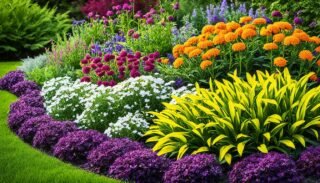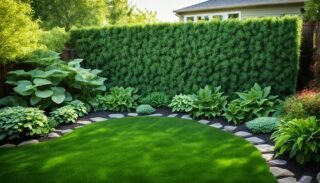Table of Contents
- Understanding Xeriscaping: A Water-Wise Approach to Landscaping
- Selecting Drought-Tolerant Plants for Your Xeriscape
- Xeriscaping Tips for Water Conservation: Essential Techniques
- Soil Preparation and Amendment for Xeriscaping Success
- Designing Your Xeriscape: Layout and Zoning Strategies
- Maintaining Your Xeriscape: Low-Water Care Practices
- Water-Saving Irrigation Methods for Xeriscapes
- Transitioning Your Existing Landscape to a Xeriscape
- Xeriscaping Success Stories: Before and After Transformations
- FAQ
- What is xeriscaping, and why is it important?
- Can a xeriscape still look visually appealing?
- What types of plants are suitable for xeriscaping?
- How can I ensure proper irrigation in a xeriscape?
- Is it difficult to maintain a xeriscape?
- Can I convert my existing landscape to a xeriscape?
- How much water can I save by implementing xeriscaping?
Can a garden be lush and save water? Exploring xeriscaping shows how we can make our gardens both beautiful and water-efficient. This approach to gardening is essential in our changing climate. By using drought-resistant plants and smart designs, we can have lovely outdoor spaces that use less water.
Xeriscaping cuts down on water bills and maintenance. It’s not just about replacing grass with gravel. It’s about making our yards into vibrant places that need little water. With plants like succulents and native wildflowers, we have many options for creative and eco-friendly gardens.
Key Takeaways
- Xeriscaping dramatically reduces water consumption in landscaping
- Drought-resistant plants are key to successful water-wise gardens
- Proper design can create beautiful, low-maintenance landscapes
- Native plants are ideal for sustainable xeriscaping projects
- Water-wise landscaping can lower utility bills and save time
Understanding Xeriscaping: A Water-Wise Approach to Landscaping
I’ve found a way to save water and make my yard look great. It’s called xeriscaping. This method is great for those who want a yard that uses less water. Let me tell you more about it.
What is xeriscaping?
Xeriscaping is a way to landscape that uses plants that don’t need much water. It’s about working with nature, not fighting it. By picking plants that are native and grouping them right, I can have a beautiful yard that uses less water.
Benefits of xeriscaping for water conservation
Xeriscaping has many benefits:
- Reduces water consumption by up to 60%
- Lowers maintenance time and costs
- Eliminates the need for chemical fertilizers
- Attracts local wildlife and pollinators
Debunking common myths about xeriscaping
Some think xeriscaping means a yard full of rocks and cacti. But, I’ve seen beautiful xeriscape gardens with lots of flowers and greenery. Another myth is it’s too expensive. While it might cost more at first, the savings on water bills and upkeep make it worth it for eco-friendly gardening.
Selecting Drought-Tolerant Plants for Your Xeriscape
Choosing the right plants is key for a successful xeriscape. Native plants, succulents, Mediterranean plants, and low-water perennials are great picks. They’re made to live in dry places, ideal for saving water in your garden.
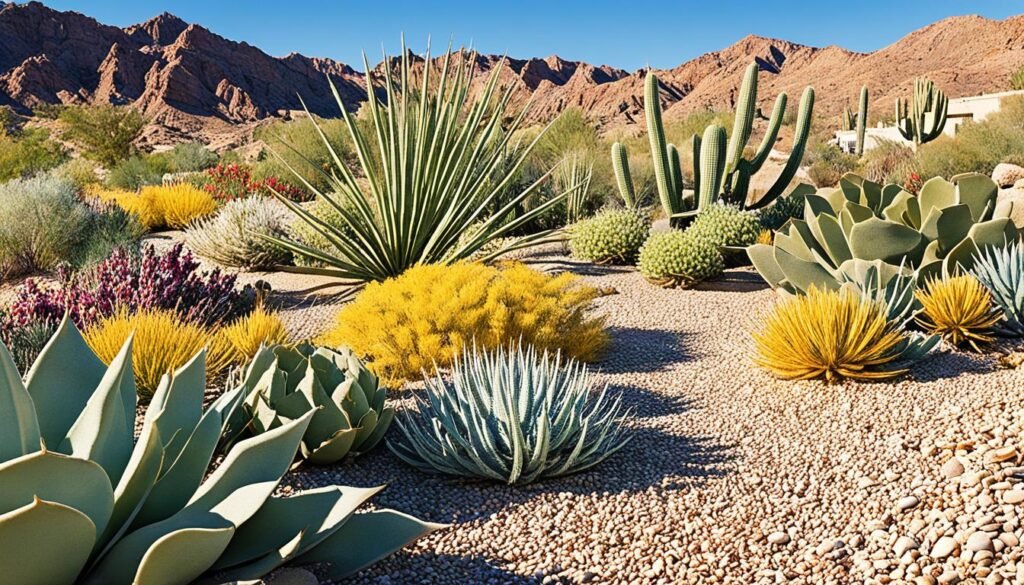
Native plants are my top choice for xeriscaping. They fit well with the local weather and need little care. In the Southwest, I prefer yucca and agave. For the Midwest, coneflowers and black-eyed susans are great.
Succulents store water inside them. Sedums, echeverias, and aloes bring unique textures and colors to your garden. They’re great for rock gardens or as highlights.
Mediterranean plants do well in hot, dry summers. Lavender, rosemary, and sage look and smell great. They’re tough and can survive droughts.
Low-water perennials offer beauty with little work. Some top picks include:
- Yarrow
- Russian sage
- Blanket flower
- Penstemon
It’s important to pick plants that fit your climate and soil. With the right plants, you’ll have a beautiful, water-saving garden that does well every year.
Xeriscaping Tips for Water Conservation: Essential Techniques
I’ve found some great xeriscaping tips that help save water in your garden. These methods are key to making a big impact on water use.
Grouping Plants with Similar Water Needs
Hydrozoning is a clever way to arrange your garden. I put plants with the same water needs together. This lets me water each group efficiently, giving them exactly what they need without wasting water.
Implementing Efficient Irrigation Systems
Drip irrigation has changed the game for my xeriscape. It sends water straight to the roots, cutting down on evaporation and runoff. I’ve seen it use up to 50% less water than old-school sprinklers.
Utilizing Mulch to Retain Soil Moisture
Organic mulch is my go-to for keeping soil moist. I lay down a 2-3 inch layer around plants to keep the soil cool and moist. It also stops weeds and adds nutrients as it breaks down. Pine needles, bark chips, or compost are perfect for my xeriscape.
Using these methods together has really reduced my garden’s water use. Hydrozoning, drip irrigation, and organic mulch create a landscape that’s both lovely and efficient.
Soil Preparation and Amendment for Xeriscaping Success
Great xeriscaping begins with the right soil. It’s essential for a landscape that uses water wisely. First, I do a soil analysis to know its texture and nutrients. This guides my choice of amendments.

After analyzing the soil, I work on making it better. Adding organic matter is key for holding water and helping plants grow well. Compost is my top choice. It makes the soil better and adds good bacteria.
- Test soil pH and nutrient levels
- Identify soil texture (sandy, loamy, or clay)
- Add organic matter to improve soil structure
- Use compost to enhance water retention
For sandy soils, I add lots of compost to keep water in the soil. In clay soils, I mix in organic matter for better drainage and air. My aim is to make soil that holds moisture but doesn’t get too wet.
Well-prepared soil is key to a successful xeriscape. It cuts down on water use, helps plants stay healthy, and makes your garden last longer.
Designing Your Xeriscape: Layout and Zoning Strategies
When I plan a xeriscape, I focus on making it both beautiful and water-efficient. I divide my yard into zones based on how much water each plant needs. This way, I save water and still have a lush outdoor area.
Creating Functional Outdoor Living Spaces
I enjoy designing spots for family and friends to hang out. Patios, seating areas, and outdoor kitchens are great for this. I use plants that don’t need much water to frame these spots, keeping them green without wasting water.
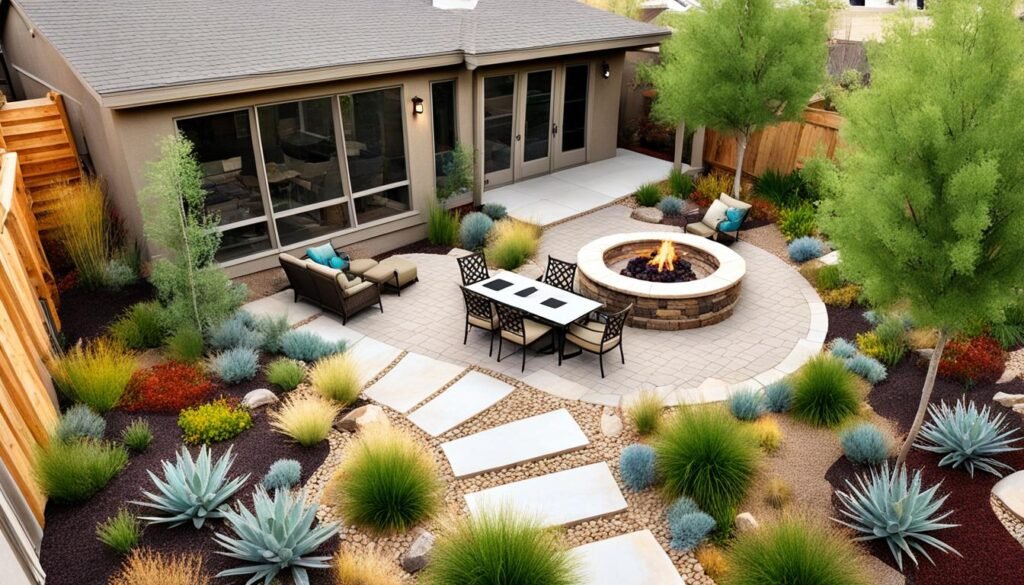
Incorporating Hardscaping Elements
Hardscaping materials are key in my xeriscape designs. I use rocks, gravel, and pavers for interesting patterns and textures. These elements look great and help reduce the need for water-hungry grass.
Balancing Aesthetics and Water Efficiency
Finding the right balance between beauty and saving water is important. I pick plants that are colorful and can survive with little water. By placing them thoughtfully, I make my xeriscape beautiful without wasting water.
A well-designed xeriscape can be as beautiful as a traditional garden. With careful planning and the right plants and materials, you can make a water-wise oasis that looks great and is sustainable.
Maintaining Your Xeriscape: Low-Water Care Practices
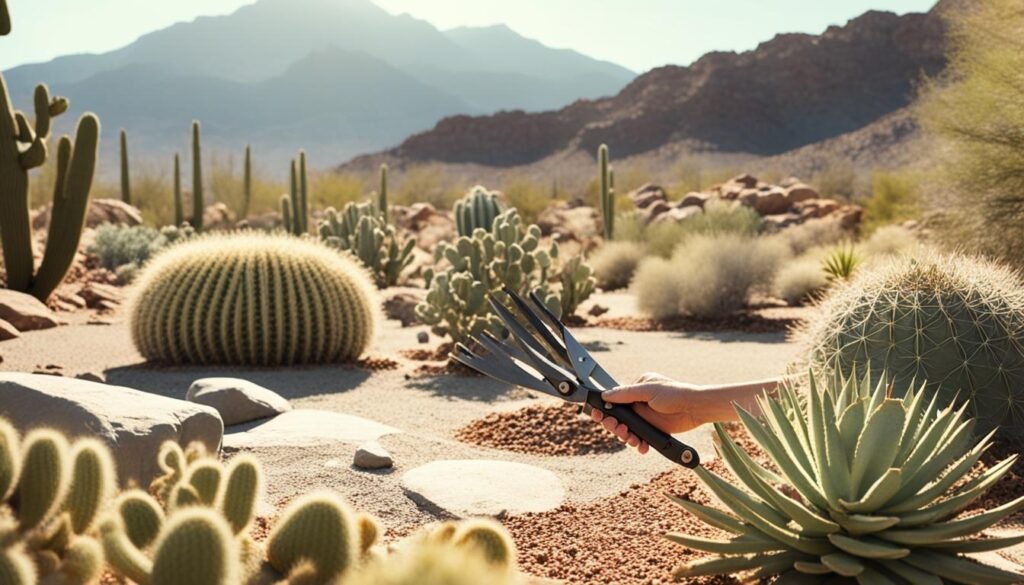
Keeping a xeriscape in top shape is easier than you think. With smart pruning and water-saving lawn care, your landscape can stay beautiful and use less water. Here are some easy tips for taking care of your xeriscape.
Pruning is vital for healthy, well-shaped plants in a xeriscape. I trim my drought-resistant shrubs and trees in early spring or late fall. This helps them grow new and stay in shape.
Dealing with weeds is important too. I use mulch to stop weeds from growing and keep the soil moist. If weeds do show up, I pull them out by hand or use safe herbicides to keep my garden clean.
For lawns, using water-efficient lawn care is a must. I cut my grass a bit taller to help the roots grow deeper and use less water. Leaving the clippings on the lawn helps as natural fertilizer and mulch.
- Use native plants adapted to local conditions
- Group plants with similar water needs
- Apply organic mulch to retain soil moisture
- Water deeply but infrequently to encourage deep root growth
By sticking to these low-water care tips, I’ve kept my xeriscape looking great and saved water. It’s good for my wallet and the planet!
Water-Saving Irrigation Methods for Xeriscapes
Water-efficient irrigation is crucial for a thriving xeriscape. Let’s look at smart ways to keep your plants hydrated without wasting water.
Drip Irrigation Systems
Drip irrigation changes the game for xeriscapes. It sends water straight to the roots, cutting down on waste. I’ve seen gardens do well with 50% less water thanks to these systems. They’re simple to set up and maintain, great for DIY fans.
Smart Controllers and Sensors
Smart watering systems have changed how I take care of my xeriscape. These advanced tools adjust watering based on the weather. They track rain, humidity, and soil moisture to make sure plants get the right amount of water. It’s like having a personal gardener!
Rainwater Harvesting Techniques
Rain barrels are a basic yet powerful way to save water. I use them to catch rainwater from my roof, which I then water my plants with. It’s incredible how much water you can save this way. Plus, plants prefer rainwater because it lacks chemicals found in tap water.
By using these methods, I’ve made a beautiful, easy-to-maintain xeriscape. It’s good for the planet and my wallet. Try them out and see your garden thrive!
Transitioning Your Existing Landscape to a Xeriscape
Changing your landscape to a xeriscape doesn’t have to be hard. You can do it step by step with gradual xeriscaping. Let’s look at how to make this change easy and effective.
Begin by checking out your current landscape. See where most water is used and start there. Replace plants that use a lot of water with ones that don’t need much water, bit by bit.
Then, work on your soil. Add things like compost to help it hold water better and drain well. This is important for your new xeriscape plants to grow well.
Change your watering system to fit your new landscape. Think about getting drip irrigation or changing sprinkler heads to use less water. Proper watering is key to making your xeriscape work.
- Replace lawn areas with permeable hardscaping or drought-resistant groundcovers
- Group plants with similar water needs together
- Add a layer of mulch to retain soil moisture and suppress weeds
By going slow with xeriscaping, you’ll get a beautiful, water-saving landscape that fits your local climate. This change saves water and cuts down on upkeep and costs over time.
Xeriscaping Success Stories: Before and After Transformations
I’ve seen some amazing xeriscape makeovers that changed bland, thirsty lawns into stunning, water-wise oases. One standout transformation was in Arizona. The before photo showed a patchy lawn that used a lot of water. The after shot revealed a vibrant desert landscape with colorful succulents and plants that don’t need much water.
In California, another impressive transformation took place. The homeowner replaced their water-hungry grass with native plants and gravel pathways. They added a small seating area surrounded by drought-tolerant plants like lavender and sage. This cut their water bill in half.
My favorite success story is from Colorado. A family turned their boring backyard into a xeriscaped haven. They used rock gardens, native grasses, and cacti for visual interest. This saved water and attracted local wildlife. It shows xeriscaping can be eco-friendly and beautiful.
These real-life examples show how xeriscape makeovers can greatly reduce water use and create beautiful outdoor spaces. Whether you live in a dry climate or want to save water, xeriscaping offers endless possibilities for beautiful, sustainable landscaping.





